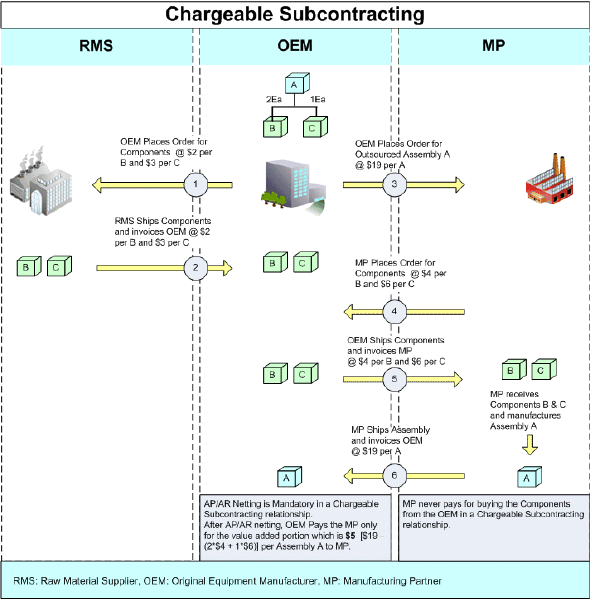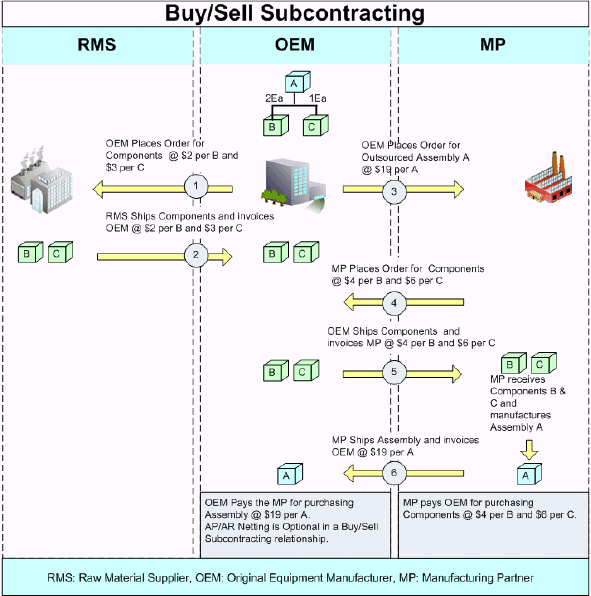Overview
This chapter covers the following topics:
Overview of Oracle Subcontracting
Subcontracting is a common business practice where a brand-owner or an Original Equipment Manufacturer (OEM) outsources its entire manufacturing operations or a portion of it by entering into a contractual agreement with an external manufacturing service provider commonly known as a Manufacturing Partner (MP).
There are different ways in which enterprises outsource their manufacturing activities. These variations are driven by the strategic decisions that are made on some of the following factors:s:
-
Extent of Outsourcing:
Enterprises can opt to outsource the entire manufacturing process or a portion of it by collaborating with a MP.
-
Nature of Component Supply:
Enterprises can either own and manage the components for consumption at the MP’s facility, or engage a supplier to either own and consign inventory, or drop ship the components at the MP’s facility. In other situations, the OEM may charge the MP by registering a sale of the components resulting in a complete transfer of ownership
-
Shipment of Finished Goods:
Enterprises can decide to either supply finished goods directly to the customer or enter into a contractual agreement with the MP to drop ship the finished goods to the customer’s facility.
Oracle supports the following types of subcontracting business practices that involve complete outsourcing of assemblies and most importantly, component sale by an OEM to a MP:
-
Chargeable Subcontracting
-
Buy/Sell Subcontracting
Chargeable Subcontracting
Chargeable Subcontracting is a practice where the OEM completely outsources the manufacturing of an assembly to an MP and makes a provisional sale of components by invoicing the MP. These components are used to build the assembly at the MP’s facility. In this practice, although the OEM registers a sale of components to the MP, the OEM still retains the ownership of the components and the inventory is reported under OEM's inventory valuation. When the OEM receives the assemblies, the MP invoices the OEM for the gross price of the assembly.
In a chargeable subcontracting relationship, the MP does not pay the OEM for purchasing the subcontracting components. The OEM pays the MP only for the value added portion in the outsourcing process, making it mandatory to net receivables invoices for components, and payables invoices for assemblies.
Chargeable Subcontracting Process

The Chargeable Subcontracting Process diagram describes the chargeable subcontracting business flow where an OEM outsources an assembly A to a MP and makes a provisional sale of components B and C to MP that are consumed at the later’s premises to manufacture assembly A. Assembly A’s bill of material constitutes of 2 Ea of B and 1 Ea of C. Although there can be different modes of component supply, in this specific example, the OEM buys components B and C from a RMS (Raw Material Supplier) and sells them to the MP. In this example:
-
OEM periodically buys Components B and C from the RMS at the rate of $2 per each unit of B and $3 per each unit of C..
-
RMS ships components and invoices OEM for supplying B and C at the rate of $2 per B and $3 per C.
-
OEM outsources the manufacturing of assembly A by raising a purchase order or a blanket release on the MP at the rate of $19 per each unit of A.
Note: The purchase price of the assembly is determined considering the components’ sales price and the value added in the manufacturing process.
-
MP orders components B and C from OEM at the rate of $4 per each unit of B and $6 per each unit of C.
Note: Although the OEM buys components at a certain price, the OEM may sell the components to the MP at a different price to prevent visibility of the actual purchase costs. In this example, OEM procures B and C at $2 per each unit of B and $3 per each unit of C from RMS and sales B and C at $4 per each unit of B and $6 per each unit of C from MP.
-
Appropriate units of components B and C are allocated to the respective purchase order for A for the purpose of planning and tracking. The OEM then ships Components B and C, and invoices MP at the rate of $4 per each unit of B and $6 per each unit of C. The MP receives components B and C and manufactures A.
Note: The OEM registers a sale, but retains the ownership of the components. MP ships assembly A and invoices OEM at the rate of $19 per each unit of A.
-
OEM receives Assembly A and nets accounts receivable invoices for selling B and C and account payble invoices for purchasing assembly. The OEM pays only for the net value added in the manufacturing of A. In this example, the added value for each unit of A is calculated as:
Purchase Price per unit of A = $19
Selling Price per unit of B = $4
Selling Price per unit of C = $6
Component usage per unit of A = 2 units of B, 1 unit of C
Net Value Add per unit of A = [$19 – (2 * $4 + 1* $6)] = $5
Note: In a chargeable subcontracting relation, the MP does not pay the OEM for buying the components, making it mandatory to net subcontracting account receivables and payables.
Buy/Sell Subcontracting
Buy/Sell Subcontracting is a business practice where an Original Equipment Manufacturer (OEM) completely outsources the manufacturing of an assembly to a Manufacturing Partner (MP) by buying the assembly from the MP and most importantly, selling the components to the MP that are consumed in the manufacturing of the assembly at the MP's premises. The ownership of the components is transferred to the MP immediately after the OEM ships the components to the MP unlike Chargeable Subcontracting where the OEM retains the ownership of the components throughout the subcontracting process.
In a Buy/Sell scenario, the sale of subcontracting components and purchase of outsourced assemblies are treated as independent business transactions. Receivables and Payables are generally not netted – OEM pays the MP for purchasing the outsourced assemblies and the MP pays for buying the subcontracting components from the OEM.
Buy/Sell Subcontracting Process

The Buy/Sell Subcontracting process diagram describes a buy/sell subcontracting business flow, where the OEM outsources assembly A to an MP, buys components B and C from the RMS and sells them to the MP for manufacturing A at the later’s premises. Assembly A’s bill of material constitutes of 2 Ea of B and 1 Ea of C. In this example:
-
OEM periodically buys Components B and C from the RMS at the rate of $2 per each unit of B and $3 per each unit of C.
-
The RMS ships components and invoices the OEM for supplying B and C at the rate of $2 per B and $3 per C.
-
The OEM outsources the manufacturing of assembly A by raising a purchase order or a blanket release on the MP at the rate of $19 per each unit of A.
Note: The purchase price of the assembly includes the components’ sales price and the value added in the manufacturing process.
-
The MP orders components B and C from the OEM at the rate of $4 per each unit of B and $6 per each unit of C.
Note: Like chargeable subcontracting, the OEM may sell the components to the MP at a different price to prevent visibility of the actual purchase costs. In this example, OEM procures B and C at $2 per each unit of B and $3 per each unit of C from RMS and sales B and C at $4 per each unit of B and $6 per each unit of C from MP.
-
Appropriate units of components B and C are allocated to the respective purchase order for A for the purpose of planning and tracking. The OEM ships Components B and C, and invoices MP at the rate of $4 per each unit of B and $6 per each unit of C. MP receives components B and C and manufactures A.
Note: In a buy/sell subcontracting relationship, the shipment of the components to the MP results in a complete transfer of ownership of the components from the OEM to the MP.
-
The MP ships assembly A and invoices OEM at the rate of $19 per each unit of A.
-
As the sale of subcontracting components and purchase of outsourced assemblies are treated as independent business transactions, the OEM pays the MP for buying assembly A at the rate of $19 per unit of A, and the MP pays the OEM at the rate of of $4 per each unit of B and $6 per each unit of C.
Note: Unlike chargeable subcontracting, netting of subcontracting account receivables and payables is optional for Buy/Sell subcontracting.
Major Features of Subcontracting
Subcontracting features include:
-
Modeling of OEM and MP as inventory organizations to facilitate tracking and simulation of subcontracting processes.
-
Accounting transactions in the MP org are not posted to the General Ledger (GL) to avoid any unwanted financial impact.
-
Chargeable Subcontracting support is only for Standard Costing Orgs and can be deployed in Japan, Taiwan, and Korea.
-
Buy/Sell Subcontracting support is for Standard, Average, FIFO and LIFO costing methods and can be deployed in any country.
-
-
Separate tracking of accounting transactions and variances associated with subcontracting component sales in the OEM Org by setting up different accounts for Subcontracting COGS, Subcontracting Revenue, and Subcontracting Receivables.
Note: This is relevant only for chargeable subcontracting as the component sale is virtual in nature and the OEM retains the ownership of the components even after the sale.
-
Integrated planning (using ASCP) and subcontracting execution in discrete and project manufacturing environments to manage and control processes throughout the extended supply chain.
-
Support for different types of component supplies both Pre-positioned and Synchronized, including the ability to drop ship components to partner’s site that help in flexibly modelling the subcontracting process in varying business conditions.
-
Automatic creation of Discrete Jobs in the MP Org to simulate assembly production at the MP’s facility in response to a purchase order or a blanket release (referred to as Subcontracting Orders in the subcontracting solution) through a concurrent program referred to as Interlock Manager.
-
Automatic creation of component purchase orders (referred to as Replenishment Purchase Orders in the subcontracting solution) for purchasing components from OEM and creation of corresponding component sales orders (referred to as Replenishment Sales Orders in the subcontracting solution) for shipping components to the MP through the Interlock Manager.
-
Automatic allocation of the Replenishment Sales Order component supplies to corresponding Subcontracting Orders for outsourced assemblies through the Interlock Manager.
-
Automatic receipt of components in the MP Org based on in transit lead times through a concurrent program referred to as Auto Receive Components eliminate any manual effort involved in performing such transactions.
-
Automatic completion of the discrete job, backflushing of components and appropriate inventory balancing in the MP Org upon receipt of the outsourced assembly in the OEM Org for ensuring accuracy of inventory records that better planning and control through a concurrent program reffered to as Process Receiving Transactions.
-
Dedicated Subcontracting Workbench and Reports providing better tracking and increased visibility throughout the subcontracting life cycle.
-
Ability to manage subcontracting process exceptions (over or under consumption, component and assembly returns, etc) helps in taking care of process variations and discrepancies.
-
Option to net subcontracting payables and receivables through the AP/AR Netting feature streamlines the payment process and provides greater flexibility in conducting business with partners.